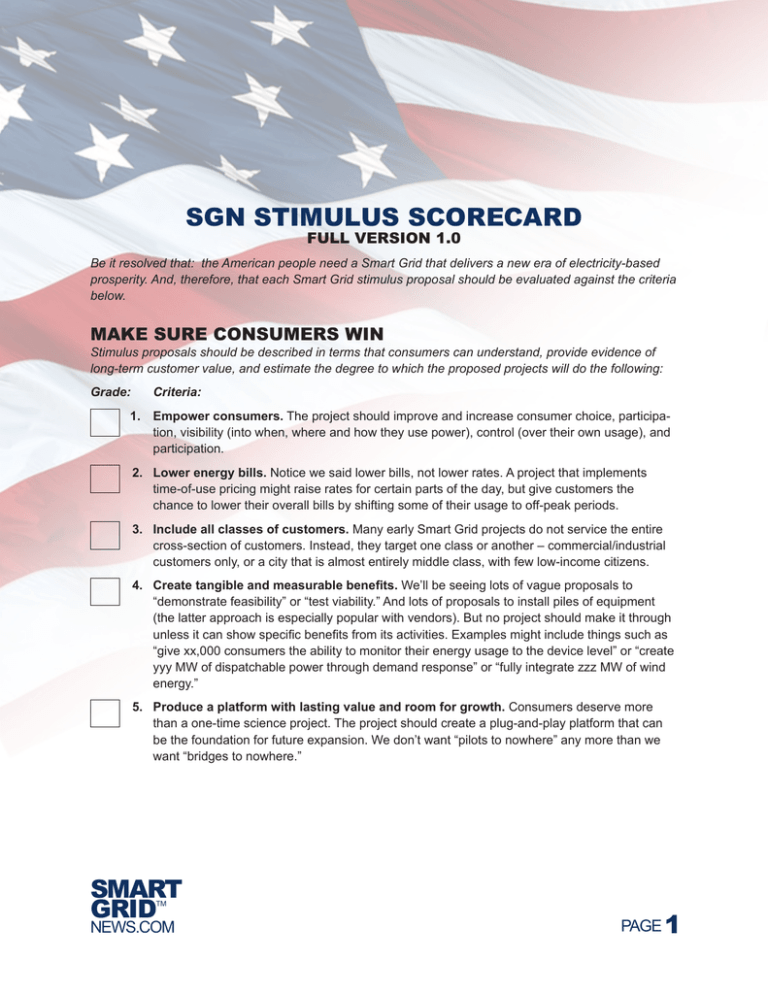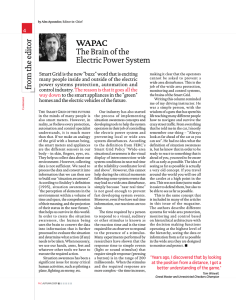SGN STIMULUS SCORECARD
advertisement

SGN STIMULUS SCORECARD FULL VERSION 1.0 Be it resolved that: the American people need a Smart Grid that delivers a new era of electricity-based prosperity. And, therefore, that each Smart Grid stimulus proposal should be evaluated against the criteria below. MAKE SURE CONSUMERS WIN Stimulus proposals should be described in terms that consumers can understand, provide evidence of long-term customer value, and estimate the degree to which the proposed projects will do the following: Grade: Criteria: 1. Empower consumers. The project should improve and increase consumer choice, participation, visibility (into when, where and how they use power), control (over their own usage), and participation. 2. Lower energy bills. Notice we said lower bills, not lower rates. A project that implements time-of-use pricing might raise rates for certain parts of the day, but give customers the chance to lower their overall bills by shifting some of their usage to off-peak periods. 3. Include all classes of customers. Many early Smart Grid projects do not service the entire cross-section of customers. Instead, they target one class or another – commercial/industrial customers only, or a city that is almost entirely middle class, with few low-income citizens. 4. Create tangible and measurable benefits. We’ll be seeing lots of vague proposals to “demonstrate feasibility” or “test viability.” And lots of proposals to install piles of equipment (the latter approach is especially popular with vendors). But no project should make it through unless it can show specific benefits from its activities. Examples might include things such as “give xx,000 consumers the ability to monitor their energy usage to the device level” or “create yyy MW of dispatchable power through demand response” or “fully integrate zzz MW of wind energy.” 5. Produce a platform with lasting value and room for growth. Consumers deserve more than a one-time science project. The project should create a plug-and-play platform that can be the foundation for future expansion. We don’t want “pilots to nowhere” any more than we want “bridges to nowhere.” SMART GRID TM NEWS.COM PAGE 1 MAKE SURE UTILITIES WIN Stimulus projects should enhance the operations and viability of the nation’s utilities by adhering to the following criteria. Grade: Criteria: 6. Open, interoperable, and secure. The Internet is only valuable because it is based on open standards. Likewise, Smart Grid projects must be open and interoperable. And they must have cyber and physical security baked in from the beginning. 7. Uses a systems approach. Pioneering leaders such as the Modern Grid Initiative and Erich Gunther (winner of the 2008 Smart Grid Technology Leadership Award) have been stressing the need for a holistic view for years. Fortunately, modern “system of systems” engineering provides proven methods that can be applied to utility projects. 8. Super-sized. We don’t need government help for yet another rinky-dinky pilot. To create jobs and real benefits, we need large deployments. 9. Scalable and replicable. It’s not enough to be big to start with. Any project paid for with stimulus money should be built from the beginning for future expansion and cannot have “low ceilings” on the number of users or megawatts. 10. Regional, not parochial. Stimulus projects should involve (or, at a minimum, be capable of expanding to) multiple utilities. We can no longer afford the redundancy and lack of interoperability that comes from the warlord mentality. 11. Improves resiliency. It goes without saying that a project can’t make reliability worse. But projects should get extra credit if they actively improve system stability. Examples include firming up wind; remote monitoring and diagnosis; wide area management; computer-assisted optimization; outage management; and many more. 12. Includes the business case. In many cases, utilities will have to pass some of the costs through to ratepayers. Stimulus proposals should include a cost-benefit analysis. MAKE SURE THE COUNTRY WINS Taxpayer-funded stimulus projects should contribute to national economic and energy goals by demonstrating that they provide the following: Grade: Criteria: 13. Short-term jobs. Proposals should specify how fast the project will deploy, how many jobs will be created, and how those calculations were made. 14. Long-term economic benefit. The Recovery Act calls for investments in “infrastructure that will provide long-term economic benefit.” As noted above in #5, winning proposals should create a lasting asset that will be an engine for future jobs and prosperity. 15. Accountability. Proposals should specify the process by which they will provide complete transparency and regular progress reports against the metrics laid out in the Scorecard. SMART GRID TM NEWS.COM PAGE 2 16. Above and beyond. Proposals must not be a request to fund a program that was already planned or underway. The stimulus bill was not intended as a rebate program. We will get neither short-term jobs nor long-term benefits unless our tax monies are paying for new projects above-and-beyond what utilities had in place already. 17. Innovation. The Recovery Act calls for investments “spurring technological growth in science” in general and “activities to modernize the grid” in particular. Spending this once-in-a-lifetime money on last-century technology is a recipe for further stagnation. We have the ability to manage the risk and still innovate. 18. An implementation plan and experienced team. Implementing a major project requires project management tools and experience. If the DOE simply hands a pile of cash to an organization that has never run a large program, the money will disappear in confusion. The proposing team should include a systems integrator or “prime contractor” with a track record delivering complex, large-scale technology projects. 19. A plan for the matching funds. The legislation requires a 50% match. Where will that money come from? Proposals must have a clear and realistic plan for obtaining matching funds. (We think the best proposals will include a mechanism to allow private sector capital to contribute.) MAKE SURE THE PLANET WINS Although no project can be all things to all people, winning proposals should promote sustainability by including as many environmental, climate, and efficiency benefits as possible. Grade: Criteria: 20. Environmentally beneficial. The best projects will be more than environmentally benign. They will produce significant and measurable reductions in greenhouse gas emissions, pollutants, and water usage. 21. Enables renewables. Today we have no way to transport large quantities of renewable energy from where it is made to the urban areas where it is needed. Nor is the current grid capable of withstanding the stress created by intermittent wind and solar. The ideal project will offer solutions to one or more of those challenges. 22. Enhances demand response. For a long list of reasons, it is cheaper and more desirable to meet our energy needs by reducing demand than by improving supply. 23. Improves energy efficiency. In addition to “passive” efficiency from things such as weatherization, there are many ways to wring more efficiency from the system itself, from reducing line losses, to using computers to optimize the placement of assets, to using sensors and monitors to safely run the system closer to capacity (saving the need to build “just-in-case” plants and lines that aren’t really needed). SMART GRID TM NEWS.COM PAGE 3 SGN STIMULUS SCORECARD SHORT VERSION 1.0 Be it resolved that: the American people need a Smart Grid that delivers a new era of electricity-based prosperity. And, therefore, that each Smart Grid stimulus proposal should be evaluated against the criteria below. MAKE SURE CONSUMERS WIN Stimulus proposals should be described in terms that consumers can understand, provide evidence of longterm customer value, and estimate the degree to which the proposed projects will do the following: Grade: Criteria: MAKE SURE THE COUNTRY WINS Taxpayer-funded stimulus projects should contribute to national economic and energy goals by demonstrating that they provide the following: Grade: Criteria: 1. Empower consumers. 13. Short-term jobs. 2. Lower energy bills. 14. Long-term economic benefit. 3. Include all classes of customers. 15. Accountability. 4. Create tangible and measurable benefits. 16. Above and beyond. 5. Produce a platform with lasting value and room for growth. 17. Innovation. 18. An implementation plan and experienced team. 19. A plan for the matching funds. MAKE SURE UTILITIES WIN Stimulus projects should enhance the operations and viability of the nation’s utilities by adhering to the following criteria: Grade: Criteria: 6. Open, interoperable, and secure. 7. Uses a systems approach. 8. Super-sized. 9. Scalable and replicable. 10. Regional, not parochial. MAKE SURE THE PLANET WINS Although no project can be all things to all people, winning proposals should promote sustainability by including as many environmental, climate, and efficiency benefits as possible. Grade: Criteria: 20. Environmentally beneficial. 21. Enables renewables. 22. Enhances demand response. 23. Improves energy efficiency. 11. Improves resiliency. 12. Includes the business case. SMART GRID TM NEWS.COM


